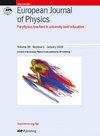大学生对典型波光学图案的认识
IF 0.8
4区 教育学
Q4 EDUCATION, SCIENTIFIC DISCIPLINES
引用次数: 0
摘要
识别和区分典型的干涉和衍射图样是学习波光学的预期学习成果之一。以往的研究表明,高中生在完成这项任务时存在困难。在本研究中,我们调查了大学生分辨由双缝、单缝和衍射光栅获得的典型波光学图案的能力。我们还利用眼动仪了解了学生在完成任务时的视觉注意力分布情况。结果显示,大学生在识别波光学图案时遇到的困难与高中生相似。他们大多在识别单色光的双缝干涉图案和衍射光栅图案时感到吃力,而在识别白光在光栅上的衍射图案和单缝衍射图案时则较为成功。眼动跟踪数据还显示,在有关白光在光栅上的衍射图案的问题中,学生花在彩色图案上的时间多于花在灰色图案上的时间,这表明他们知道衍射光栅将白光分成了不同的颜色。在有关单色光图案的问题中,学生总体上主要注意的是单缝衍射图案,这可能是因为它有明显的中心最大值。此外,与文字相比,图案的固定时间更长,这意味着学生认为从文字中提取信息比从图案中提取信息更容易。之前没有研究将解题过程中的转换次数与答案的准确性进行过比较。在本研究中,我们观察到,解题错误的学生在问题和选项之间以及不同选项之间的凝视转换次数明显较多。本研究的结果表明,对于大学生来说,识别典型的波光学模式也是困难的,因此建议在讲座演示和学生实验室中,应更加注重系统地观察和识别基本波光学现象的关键特征。本文章由计算机程序翻译,如有差异,请以英文原文为准。
University students’ recognition of typical wave optics patterns
The recognition and distinction of typical interference and diffraction patterns are among the expected learning outcomes of studying wave optics. Previous studies have reported high school students’ difficulties with this task. In this study, we investigated university students’ ability to distinguish typical wave optics patterns obtained by the double slit, single slit, and diffraction grating. We also used eye tracking to obtain an insight into the distribution of students’ visual attention during the task. The results showed that university students had similar difficulties in recognizing wave optics patterns as high school students. They mostly struggled with identification of the double-slit interference patterns and diffraction grating patterns of monochromatic light while they were more successful in recognition of the diffraction pattern of white light on an optical grating and single-slit diffraction patterns. The eye-tracking data also revealed that students spent more time attending colourful than grey patterns in questions regarding diffraction of white light on an optical grating, thus suggesting that they were aware that the diffraction grating separates white light into colours. In questions regarding monochromatic light patterns, students overall mostly attended the single-slit diffraction pattern probably because of its distinct central maximum. Furthermore, the longer fixation duration for patterns compared to the text implies that students found it easier to extract information from the text than from the patterns. No prior research has compared the number of transitions during problem solving with the accuracy of the answers. In this study, we observed that students who incorrectly solved a task demonstrated a significantly higher number of gaze transitions between the question and the options, as well as among different options. The results of this study indicate that the recognition of typical wave optics patterns is also difficult for university students, thus suggesting that more attention should be paid to systematic observation and identification of key features of basic wave optics phenomena in lecture demonstrations and student laboratories.
求助全文
通过发布文献求助,成功后即可免费获取论文全文。
去求助
来源期刊

European Journal of Physics
物理-物理:综合
CiteScore
1.70
自引率
28.60%
发文量
128
审稿时长
3-8 weeks
期刊介绍:
European Journal of Physics is a journal of the European Physical Society and its primary mission is to assist in maintaining and improving the standard of taught physics in universities and other institutes of higher education.
Authors submitting articles must indicate the usefulness of their material to physics education and make clear the level of readership (undergraduate or graduate) for which the article is intended. Submissions that omit this information or which, in the publisher''s opinion, do not contribute to the above mission will not be considered for publication.
To this end, we welcome articles that provide original insights and aim to enhance learning in one or more areas of physics. They should normally include at least one of the following:
Explanations of how contemporary research can inform the understanding of physics at university level: for example, a survey of a research field at a level accessible to students, explaining how it illustrates some general principles.
Original insights into the derivation of results. These should be of some general interest, consisting of more than corrections to textbooks.
Descriptions of novel laboratory exercises illustrating new techniques of general interest. Those based on relatively inexpensive equipment are especially welcome.
Articles of a scholarly or reflective nature that are aimed to be of interest to, and at a level appropriate for, physics students or recent graduates.
Descriptions of successful and original student projects, experimental, theoretical or computational.
Discussions of the history, philosophy and epistemology of physics, at a level accessible to physics students and teachers.
Reports of new developments in physics curricula and the techniques for teaching physics.
Physics Education Research reports: articles that provide original experimental and/or theoretical research contributions that directly relate to the teaching and learning of university-level physics.
 求助内容:
求助内容: 应助结果提醒方式:
应助结果提醒方式:


